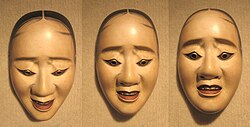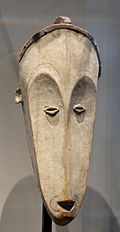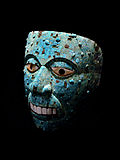Mask



A mask is a type of clothing which covers the face. It is similar to a veil, but more close-fitting.
Uses
There are different reasons why people use masks.[1] A person can use a mask so others do not know who they are (as when committing a crime). Or, a mask may keep someones face safe from harm (like a gas mask so harmful gases do not get into the lungs).
There are many practical uses for masks in everyday life. Mostly, the masks used are semi-masks which cover only the bottom half of the face, the mouth and nose. An example is the use of masks in operating theatres, and by wood-workers. In surgery, the purpose is to keep bacteria off the patient; in wood-working the purpose is to keep wood fibres out of the lungs.
In Venetian masks only the top half of the face is covered, to prevent recognition. Ice hockey masks, used in the Hannibal Lecter movies, cover the whole face to protect it from the hockey puck moving at high speed.
Origin
The word
The word 'mask' might have come from other languages. The French masque, the Italian maschera, the Spanish máscara, the Latin (not classical) mascus/masca (meaning "ghost") or the Arabic maskharah (meaning "jester" or "man in masquerade") all use the same word.
History
One of the oldest masks found is the Death Mask. This stone mask is 9000 years old and is probably the oldest mask in the world. It is kept in Musée de la bible et Terre Sainte, Paris.
There are also three masks from the same period, kept in The Israel Museum, Jerusalem.
Masks are used in many magical or shamanistic rituals in non-western societies.[2] The celebration or appeasement of animistic spirits takes place with dance and song in ancient performances in many parts of the world. In these events performers use costumes and masks to mimic the supposed spirits.[3]
From this kind of beginning, the use of masks in ancient Greek theatre may have started. The actors and chorus in this early theatre all used masks.
Masks in recent times
Masks have been used to protect people against air-borne diseases. They were worn during the plague in the Middle Ages;[4] during the influenza epidemic of 1918, and the COVID-19 epidemic. Gas masks were issued in World War II even though phosgene gas was never used in that war (it had been in WWI).
During the 2019-20 coronavirus pandemic, a new variation of trikini, with two pieces for the body and a face mask was designed.[5] Indian film actress Kajol popularized the idea of this trikini.[6]
Figurative uses
There are some other uses of the word 'mask', which arise by extension. That means using 'mask' as a metaphor. In film a mask is a screen which cuts out part of the image. In social theory, a mask is the behaviour a person takes on in his role or job. Thus policemen, head teachers, army commanders, prime ministers act as they are expected to act (most of the time). The inference is that behind the mask is the 'real' person. Their role is a mask. As a verb, 'to mask' means to cover or hide.
Mask Media
Papierkrattler masks at the Narrensprung 2005 Carnival parade, Ravensburg, Germany
The so-called 'Mask of Agamemnon', a 16th-century BC mask discovered by Heinrich Schliemann in 1876 at Mycenae, Greece, National Archaeological Museum, Athens
Theatrical masks of Tragedy and Comedy. Mosaic, Roman mosaic, second century AD
Batak mask dance at a funeral feast in the Dutch East Indies, 1930s
Asaro mudman holding mask, Papua New Guinea
Aztec mask of Xiuhtecuhtli, c. 1500, of Mixtec-Aztec provenance
Related pages
References
- ↑ Lommel, Andreas 1970. Masks: their meaning and function. Ferndale Editions, London.
- ↑ Chris Rainier and Meg Taylor 1996. Where the masks still dance: New Guinea. Bulfinch Press/Little, Brown. ISBN 0-8212-2261-9
- ↑ John Emigh 1996. Masked performance. University of Pennsylvania Press. ISBN 081221336X
- ↑ This was not caused by an airbourn virus, but by close association with rats.
- ↑ Prasad, Amrita PrasadAmrita. "Bikinis, saris or LBDs: Post corona, all your outfits may come with matching masks in 2020" (in en). Bangalore Mirror. https://bangaloremirror.indiatimes.com/bangalore/others/bikinis-saris-or-lbds-post-corona-all-your-outfits-may-come-with-matching-masks-in-2020/articleshow/75388567.cms. Retrieved 28 April 2020.
- ↑ "What Kajol Thinks A Trikini Suitable For 2020 Should Look Like". NDTV.com. https://www.ndtv.com/entertainment/what-kajol-thinks-a-trikini-suitable-for-2020-should-look-like-2214889. Retrieved 28 April 2020.













